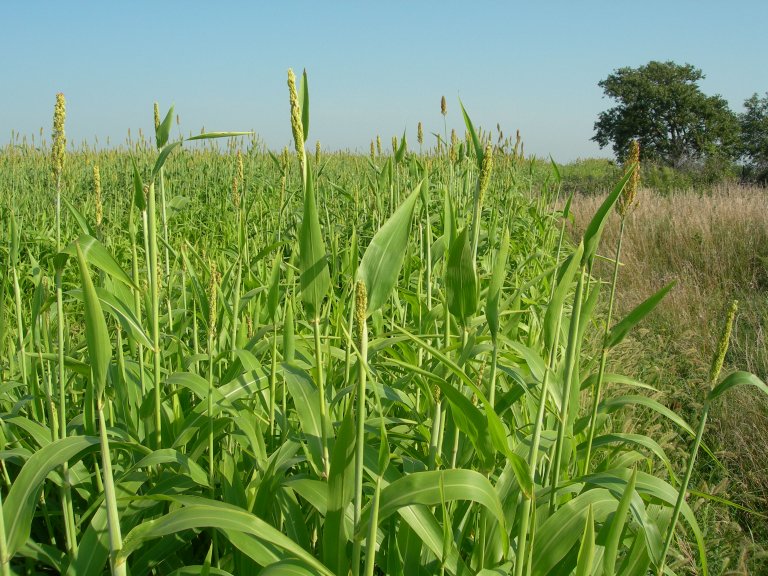
By Bruce Anderson, UNL Forage Specialist
DON'T PLANT SUMMER ANNUALS TOO EARLY
Once corn, beans, and other crops are all planted, it's natural to be anxious to plant your summer annual forage grasses. But don't rush. Too early is bad for these crops.
Summer annual forage crops - like sudangrass, millets, cane, teff, and sorghum-sudan hybrids - are hot weather crops. And when I say hot weather, that means not only that they grow best in hot weather, it also means they can be injured or even permanently stunted by cool weather.
So, even though you might finish other planting and it seems like summer is already here, don't plant summer annuals too early.
Always wait to plant summer annual forage grasses - any summer annual forage grass - until soil temperature will remain permanently above 60 degrees. And soil should be at least 65 to 70 degrees for the millets and teff. Late May at the earliest, early June in many cases.
Not only that, air temperature also must remain warm, even at night. If either soil or air temperature gets too cold some summer annual grasses can be stunted permanently, no matter how nice the growing conditions are later on.
True sudangrass might tolerate cool temperatures best of all the summer grasses. I don't know the exact limits, but if soil stays above 55 degrees and air temperature gets no lower than 40, I think sudangrass eventually will recover from the cold stress. On the other hand, millets and some forage sorghums may never snap out of the stress caused by a 45, maybe even a 50 degree night.
So don't rush to plant summer annual grasses. Even if they don't get stunted, the few days you gain for earlier grazing is pretty small compared to the risk of losing much of their growth potential.
USING GRAZING TO CONTROL PASTURE WEEDS
Pasture weeds are a problem for many of us. It’s a challenge to control or prevent them in the first place.
If you have weedy pastures, first ask yourself – Why? Nearly always the existing forage stand was not thick or vigorous enough to out-compete invading weeds. So the next step in pasture weed control must be to manage pastures so they can be competitive. That may include fertilizer, extra seeding, and especially well-managed grazing.
Once weeds become a problem, though, control strategies must be used. One technique is to heavily stock a pasture, maybe with a ten-fold higher concentration of animals per acre than usual, for a very short time. Only do this if your good grass is healthy.
You might need to use temporary cross fences to create small enough areas to achieve these high animal concentrations. If this is done while problem weeds are still young, many of them will be eaten readily. Weeds like crabgrass, foxtail, lambsquarter, and field bindweed make good forage when young. Animals even eat cheatgrass, downy brome, and sandbur when plants are young. Once they form seed stalks, though, cattle almost totally reject them. Be sure to remove animals while desired grasses still have a few leaves remaining so they regrow quickly and compete with recovering or new weeds.
Some established weeds aren’t controlled easily with grazing. Clipping or spraying these weeds when their root reserves are low and to prevent seed production will reduce their pressure. But remember, they will return quickly unless follow-up grazing management keeps your pasture healthy, vigorous, and competitive.
Pasture weeds are troublesome, but proper grazing helps control them.
For more UNL Beef information go to http://beef.unl.edu